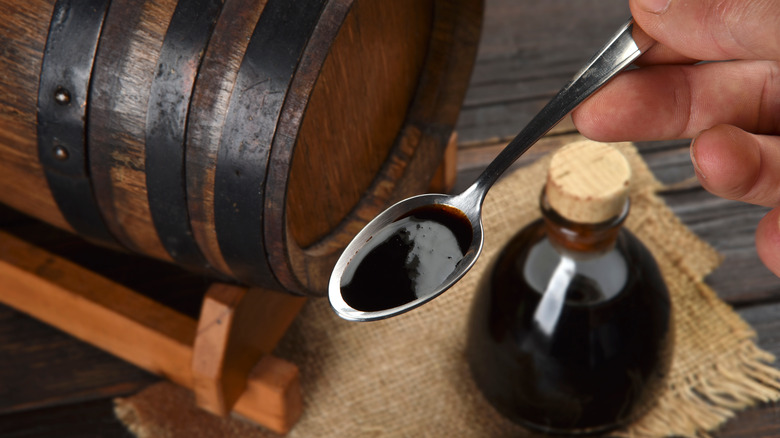How To Shop For Balsamic Vinegar, According To Giada De Laurentiis
Anyone that has ever had a thick, sweet syrup-like taste of balsamic vinegar probably knows there's no going back to the thinner, more vinegary versions. But figuring out how to make sure you're buying something that will taste just as good can be tricky. Thankfully, understanding what balsamic vinegar is, how it is made, and what to look for can making buying a lot easier. Balsamic vinegar is made from leftover grapes from the process of making wine, which is reduced and barreled for aging, according to Giada De Laurentiis (via Giadzy). There are three main categories of balsamic vinegar to choose from — traditional, condiment-grade and commercial-grade.
Traditional is the highest quality that is aged for the longest period of time, between 12 and 25 years (via Eataly). This type usually has the official D.O.P stamp to indicate that it is an authentic-guaranteed product too. Condiment-grade balsamic vinegars are the middle-grade choice that is aged for less than 12 years, but still comes from a specific geographical region. They're often aged between three months to three years. Finally, commercial-grade means there are added ingredients such as food coloring, sugar, and vinegar among others, to the final product making it the lowest quality and cheapest balsamic vinegar.
This is what you should look for when shopping for balsamic vinegar
If you really want a great, high-quality bottle of balsamic vinegar, De Laurentiis recommends making sure you you look for the length of time that the balsamic vinegar was aged, as well as any official designations such as D.O.P. or I.G.P. for condiment-grade (via Giadzy). These will signal that the bottle is a higher quality and ensure you're getting the good stuff. If you really want to be sure, you can also check the list of ingredients. Added ingredients like sugar, thickeners and food coloring indicate that it's lower quality.
If you see any type of wine vinegar as the first ingredient or two, then it's not even real balsamic and should definitely be avoided. Even though commercial-grade or lower-quality balsamic vinegar does have a place in most kitchens, those are still things to avoid in abundance. Finally, consider how balsamic vinegar is going to be used. If it isn't a main flavor or ingredient in a dish, then low quality is okay for cooking with. Expensive high-quality balsamic vinegar should be only be used in dishes where it will really be tasted such as drizzled over caprese salad or bruschetta.

